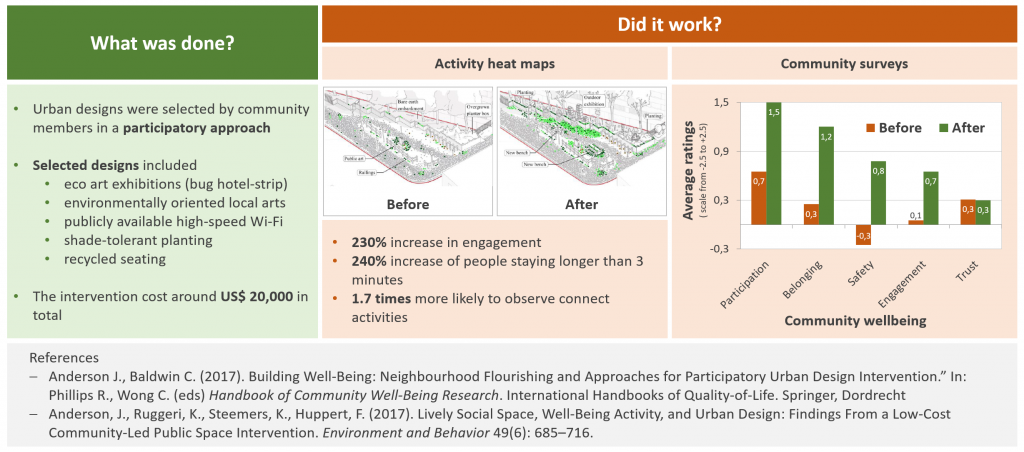Behavioral insights for city planners and architects

Community infrastructure can have a huge impact on people’s behaviors, attitudes, and habits. How can urban planning improve wellbeing, social cohesion and group identity?
Summarizing the most prominent literature in this field, here are seven behavioral insights for the design of public spaces that may help:
- Make it accessible. Understand the physical barriers of your beneficiaries. For example, consider child friendly facilities to attract more parents, comfortable seating and barrier-free facilities for the elderly to attract large family groups, or improved public transport times to attract more students.
- Make it safe. People avoid situations in which they are confronted with uncertainty and discomfort. Plan for areas that are protected from weather conditions and design spaces so that they grant sufficient levels of privacy (might differ across cultures).
- Make it clean-by-design. Litter and waste smells make public spaces unattractive. Provide sufficient numbers of litter bins and make them salient (by creating funny bin designs or by using salient stickers on the ground), ensure that waste containers are stored in adequate distance from people (especially during hot seasons), or make it a prerequisite for coffee shop and restaurant operators to employ deposit return schemes.
- Make it social. People like to gather and engage with each other at focal points. Select these focal points on purpose and tailor them to your target group’s preferences, e.g., by integrating a coffee shop, blue spaces, community sheds or gardens, areas for featured artwork, or fireplaces.
- Make it local. Engagement levels increase with ownership and acceptability. Use participatory planning processes during the need assessments and design stages, involve skilled facilitators with community ties, or encourage youth to volunteer in site operations and management at an early stage.
- Make it fun. Integrate game design elements that repeatedly allow interaction between (targeted) community members. The classic examples are playgrounds for children, walking paths, or table tennis facilities; newer and more team-oriented alternatives are walk-for-health contests or geocaching activities.
- Make it entertaining. Design the space so that it is flexible enough to facilitate future community events. Think about the possibility to host flea markets, open-air exhibitions, food truck visits, concerts, festivals, or pop-up parks, for example.
Behavioral urban planning in practice
The following poster shows how behavioral urban planning can integrate human-centered designs and measure what works to improve wellbeing.
Interested in more behavioral insights for urban designs?
Here are some recommendations for further reading in this fascinating and growing field of behavioral research.
Survey instruments designed to measure community wellbeing
- Baldwin, C., Vincent, P., Anderson, J., Rawstorne, P. (2020): “Measuring Well-Being: Trial of the Neighbourhood Thriving Scale for Social Well-Being Among Pro-Social Individuals.” International Journal of Community Well-Being.
- Anderson J., Baldwin C. (2017). “Building Well-Being: Neighbourhood Flourishing and Approaches for Participatory Urban Design Intervention.” In: Phillips R., Wong C. (eds) Handbook of Community Well-Being Research. International Handbooks of Quality-of-Life. Springer, Dordrecht
Experimental designs and procedures for public space interventions
- Anderson, J., Ruggeri, K., Steemers, K., Huppert, F. (2017). “Lively Social Space, Well-Being Activity, and Urban Design: Findings From a Low-Cost Community-Led Public Space Intervention.” Environment and Behavior 49(6): 685–716.
A review of interventions to boost community wellbeing
- Bagnall, A., South, J., Di Martino, S., Southby, K., Pilkington, G., Mitchell, B., Pennington, A., Corcoran, R. (2018): A systematic review of interventions to boost social relations through improvements in community infrastructure (places and spaces). Working Paper. What Works Centre for Wellbeing/Leeds Beckett University, Leeds.
If you are interested in behavioral urban planning, get in touch with us. We are always happy to get engaged, learn more about community challenges, and see if we can help.
Picture: © Ben Duchac on Unsplash
